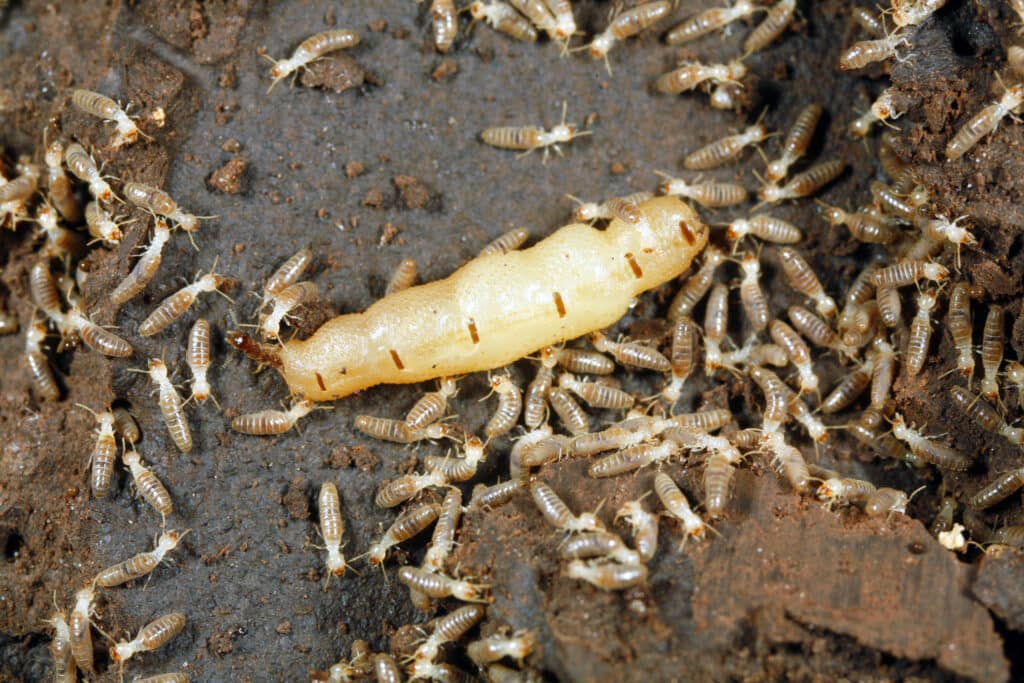Author: Kurt Treftz, Cascade Pest Control

The world of creepy, crawly insects is quite fascinating. Uncovering the amazing world of termites can help us better understand how to control and manage these pesky and destructive pests.
Read on as we delve into the life of a termite queen.
Appearance of Termite Queen
The termite queen starts her life as a flying alate. In this winged form, she mates with the king and begins her unique life of reproduction.
Size
After mating a termite queen will begin to change in appearance. Her abdomen stretches as she produces huge numbers of eggs. She will grow to reach a length of 4-6 inches. (From the size of a pinky nail to the size of an index finger).
While the termite queen’s body grows exponentially, her head and legs remain the same size. Eventually, the queen will become so engorged that her head and legs stick straight out from her large body. Without the strength or traction to move her bloated body, she is essentially trapped in her breeding chamber for the rest of her life.
Color
Because of the huge number of eggs stretching the termite queen’s body, the exoskeleton will look almost translucent. In the Pacific Northwest region, we have subterranean and dampwood termites. Subterranean queens are light or white due to the taut nature of their skin. Dampwood queens can appear brown like the workers, but can range from dark to light, and can even be reddish.
Lifespan of a Termite Queen
As mentioned, the termite queen begins her life like any other alate (winged reproductive). Once she finds and mates with her king, she begins her role. The queen and king will start a new colony of termites. The queen is usually the longest-lived of any termite. On average a queen can live 10-25 years, with some species living as long as 50 years.
During her most productive years, the termite queen can lay several thousand eggs in a day. In temperate climates, she can lay year-round. A single queen can lay up to a hundred million eggs in her lifespan. She will be most productive for about 7 years.
Throughout her life, the termite queen emits a pheromone, preventing new queens from forming. When she reaches the end of her life, that pheromone fades to indicate that a new queen is needed. This will trigger a secondary reproductive to emerge to replace her. (She can also control the colony’s need for new reproductives in the same way throughout her life.)
Role in the Termite Queen in the Colony
Founder of colony
First, the queen is the founder of the termite colony. Along with her mate, the king, she begins producing workers. These workers are the ones who build the elaborate tunnels & chambers, farm the fungus, forage for food, care for the young, and tend to the queen.
Protected by the colony
One of the main goals of the termite colony is to protect the queen. She is often located in the center of the nest, well-surrounded, and far from danger. The worker termites tend to her needs, taking the eggs and caring for them as they develop. Since the queen can’t move on her own, she depends on those around her for food, cleansing, and protection.
Reproducer
The termite queen exists to produce eggs for the colony. She is quite simply an egg-laying machine. She will produce millions of eggs in her lifetime. At her peak, she might deposit thousands of eggs a day.
Controller of colony size
The queen is responsible for the size of the termite colony. As the colony grows, the queen can create new queens (secondary reproductives) that can expand the existing colony or go on to start their own. Pheromones help to communicate the needs of the colony so that these new reproductives are created or not.
Mate for life
In an interesting twist, many species of termites mate for life. After their nuptial flight and mating, the king and queen termite will find a likely spot for their new colony. As the colony grows and the workers begin to build the nest, the king and queen are essentially entombed together.
The queen becomes so distended that she can’t move so the king will tend to her, living in the chamber with her. They take care of the young until enough workers are present to take over the task. The king will continue to care for the queen termite, sometimes for 20 years or more.
Need a Termite Inspection?
While we don’t want to find a termite queen who has made her colony in our homes, it is fascinating to learn how these creatures live. If you find they have tried to sneak in uninvited, call the termite experts at Cascade Pest Control 888-989-8979.
